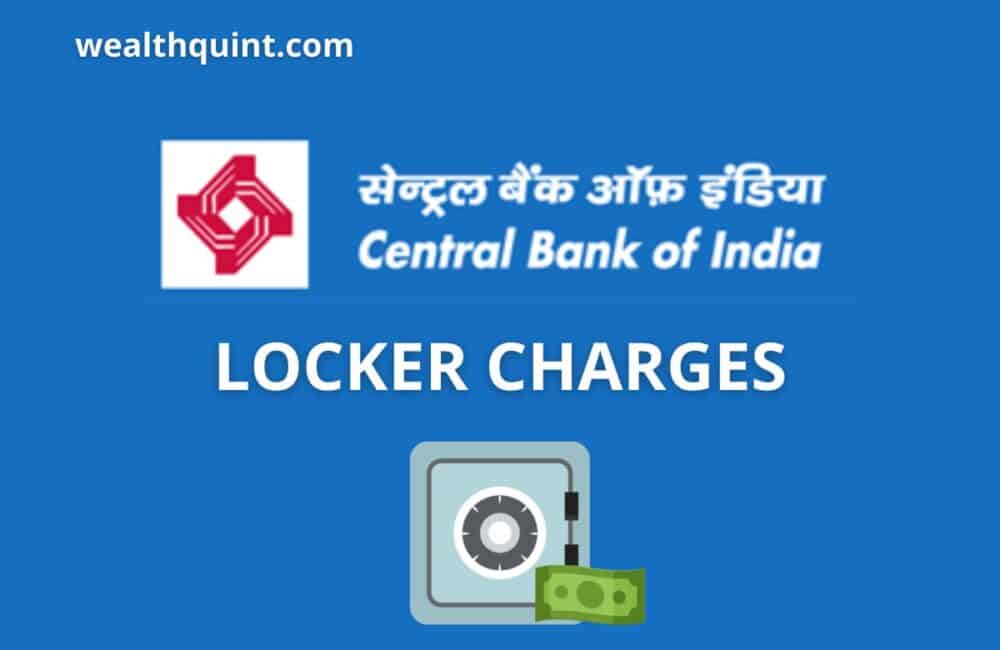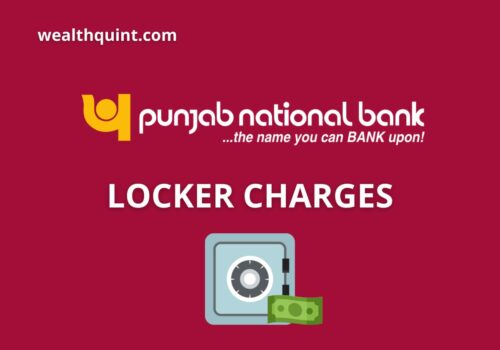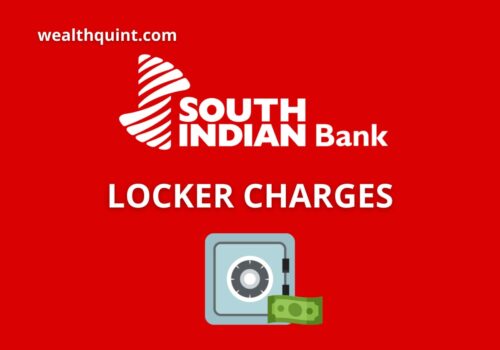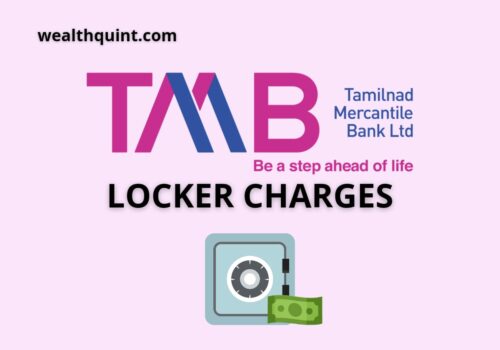Bank lockers are the specific space provided by the banks to their customers. The bank consumers can keep their valuable items such as documents, jewelry, etc., and pay some convenience fee to their particular bank.
While talking about its charges, the bank locker charges range between INR 1000 to INR 20,000 depending upon the size of the locker.
In this article, you will learn about the locker charges of the Central Bank Of India and the detailed information on what you can keep in your bank locker.
Also, what are the rules and regulations for occupying a bank locker? And the documents required to book lockers in the Central Bank Of India.
Central Bank Of India Locker Charges
| Size | Urban/Metro | Rural/Semi-Rural | Time Period |
| Group I | INR 1500 + GST | INR 1000 + GST | Annual |
| Group II | INR 2000 + GST | INR 1500 + GST | Annual |
| Group III | INR 3000 + GST | INR 2000 + GST | Annual |
| Group IV | INR 3000 + GST | INR 2000 + GST | Annual |
| Group V | INR 4000 + GST | INR 3000 + GST | Annual |
| Group VI | INR 6000 + GST | INR 4500 + GST | Annual |
| Group VII | INR 8000 + GST | INR 6000 + GST | Annual |
| Group VIII | INR 10000 + GST | INR 8000 + GST | Annual |
Central bank charges vary based on the size and geographical area of the branch, whether you choose a smaller or larger sized locker and your branch is in a rural or urban area.
The central bank has divided its locker system into various groups depending upon its size. Group 1 is the smallest-sized locker. On the other hand group, eight is the largest one.
Note: 18% GST is applicable on all the above charges.
Central Bank Of India Locker Registration Charges
The central bank charges a one-time locker registration charge when you apply for the lease of the locker. The bank charges Rs 200 (Two hundred rupees) in the branch located in rural areas; on the other hand, you will have to pay Rs 500 (Five hundred rupees) if your account is in the metro or urban areas.
Central Bank Of India Locker Per Visit Charges
The bank charges Rs. 100 (Hundred Rupees) Plus GST per visit for locker after you cross the free visit threshold.
The central bank provides 15 visits for free in a year.
Central Bank Of India Discounts On Locker Charges
The central bank provides a discount on the rent of lockers if you take this service for above one year. For instance, you occupy the CBI’s locker for one and a half years, and the bank provides you with a discount of 2% on its rental charge. However, the bank provides a 75% discount for their staff and employee.
Let’s have a look at the discount on locker rent.
| Rental discount in percent | Period |
| 2% | 18 months and above |
| 5% | 2 Years |
| 10% | 3 Years |
| 15% | 4 Years |
| 20% | 5 Years |
| 75% | For Staffs only |
Remember, you will have to pay the locker rent in advance.
Central Bank Of India Locker Security Deposit
You will have to deposit the rent amount of three years plus break opening charges plus one thousand rupees as a term deposit as a security amount in the CBI.
Central Bank Of India Locker Penalty After Due Date
The bank charges penalties after the due date on a quarterly and yearly basis, which is mentioned below.
| 10% of yearly rent | 1st Quarter |
| 25% of yearly rent | 2nd Quarter |
| 40% of yearly rent | 3rd Quarter |
| 50% of yearly rent | 1 Year |
| Locker to be broken | over 1 year |
In other words, the total amount that you will have to pay is
- 10% of the yearly rent as a penalty plus unpaid rent amount for three months plus 18% GST for the first quarter after the due date.
- For the second quarter, the locker holder will have to pay 25% of annual rent plus the due amount plus 18% GST.
- For the third quarter, you will have to pay 40% of the annual rent plus the due rent amount plus 18% GST.
- For one year, you will have to pay 50% of the annual rent as a penalty plus the due rental amount plus 18% GST.
- If you have not operated your locker for over more than a year. In this scenario, the bank keeps the right to open the locker by breaking down its lock. In this scenario, you will have to also bear the locker breaking expenses too including penalties plus rent plus GST of 18%.
Also Read: Central Bank of India Balance Check Number
Central Bank Of India Locker Benefits
- The main benefit of Central Bank Of India locker is keeping your documents, Gold, or other valuable items. The locker facility is available in almost every branch.
- It’s a safer place than Home as there is no chance of misplacing it.
- Banks lockers have two keys, and the best part of it is; you will need both keys to open them. The bank provides you with only one key, and the second one is kept in a bank.
- Central Bank Of India provide the option to choose small, medium, or large size lockers that you can choose at your convenience.
- Central Bank Of India has the safest infrastructure as they monitor the bank’s exit and entry with the help of security guards. They have the latest surveillance technology, which provides an extra layer of safety to your lockers. Such a security system is not possible at Home.
- Central Bank Of India took full responsibility for securing your precious items except for the harm that is not under the bank’s control, like earthquakes and fires. For more details, you must read their terms & condition while applying for the bank locker.
- You can claim compensation if you found any misplacement or damage in your item due to bank loopholes or negligence.
Central Bank Of India Locker Eligibility Criteria
Central Bank Of India provides locker facilities to its existing customers. Therefore, to occupy the bank locker, you will need to either open a savings bank account. Or, if you are a fixed deposit customer of that specific bank, you are eligible to occupy the bank lockers.
Also Read: Central Bank of India Mini Statement: Missed Call Number, SMS Banking
How To Avail Central Bank Of India Locker Facility?
Well, how can anyone take advantage of bank locker facilities, and what are the criteria for achieving it?
Steps to get Central Bank Of India locker facility:
- Step 1: Writing an application
In order to get locker facilities in the bank, you have to write an application regarding it to your respective branch manager. Then step forward to the next procedure by completing the KYC process.
- Step 2: Agreement
Finally, an agreement paper is signed by you, which includes all terms and policies of occupying the bank locker. The employer makes you understand all the guidelines of the bank before you sign the agreement.
- Step 3: Security
Generally, most banks demand some security or guarantee in return for providing a locker facility in the bank. Usually, the bank only gives the locker benefits to the existing customers (account holders), or who have fixed deposits, or to the willing customers for account opening.
- Step 4: Charges
A small number of charges are required for acquiring a bank locker. But the charges can vary in the matter of the size of the locker or location of the branch. The payment for the bank locker is based on per annum, and you have to pay for it in advance. It can range from INR 1000 to INR 10,000.
Document Required For Central Bank Of India Locker
Usually, the bank provides the lockers system to their existing customers. In this scenario, if you are an existing customer, you will only be required to apply to the manager.
Attach the KYC, if required, and attach a photocopy of your Aadhar and Pan card with the application.
However, if you are not an existing customer, first, you will have to open your bank account by submitting the following documents.
- Photo ID Proof- Aadhar card, passport, or Driving license
- Address Proof- Aadhar card, gas bill, or electricity bill
- Maximum 2 copies of Photograph
- Pan card
Once your account is opened, you can go with the procedure of occupying a bank locker by writing an application followed by the KYC process.
Also Read: 7 Ways To Get CIF Number In Central Bank Of India
Central Bank Of India Locker Rules
- First, you need to write an application for having the bank locker, if available.
- As per the revised guideline of RBI, the bank will have to provide a receipt when you apply to occupy a locker. The receipt includes the information about your waiting period to occupy the locker in that specific branch.
- Understand the terms and conditions and sign an agreement paper that includes all the terms and conditions of having a bank locker.
- All the banks may differ in terms of their terms and condition of occupying a locker that you need to read while applying for it.
- The bank may ask you to pay the three-year rental charge in advance when applying for a locker as per the revised guideline.
- To maintain the locker facility, you will have to keep a sufficient amount in your account to pay the annual rent of the bank locker.
- Annual rents are not refunded by the Central Bank Of India when if the customer surrenders their locker until the customer has paid annual rent in advance but surrendering the locker in a mid.
- There are late payment penalty charges applicable which can range from 2.5% to a maximum of 25% in axis bank. However, the penalty charges in other banks may be different a bit.
- The banks also offer discounts on the maintenance charge of the locker.
- The bank charges one-time registration charges plus GST for the locker. The amount will be different in the different banks or branches depending upon the location.
- The bank facilitates you to visit 3 times in a month for free after that they charge around a hundred rupees per visit. The charges and the number of free visits can differ from bank to bank.
- The Central Bank Of India is not liable for the loss of contents due to natural calamities like floods, earthquakes, fires, theft etc. However, as per the RBI guideline, the banks have to make sure that incidents such as burglary, dacoity, fire, or building collapse have not occurred due to their negligence or shortcoming.
Central Bank Of India Locker Nomination
While talking about the bank locker nomination, the bank asks you about the nominee’s name at the time of account opening.
You can add more than one nominee to your account or bank locker. The nominee is the person to whom you allow to take over your property kept in a locker if some mishap occurs to you like death.
You can add any of your family members or close one as a nominee of your account. In case you add more than one nominee, then the money will be divided to each nominee.
But, in the case of property or paper, it will be given to the mentioned one to whom the account holder stated at the time of occupying the bank locker.
After the death of the account holder, the following are the steps to gain the bank locker by nominee :
• An application is written by the nominee to the bank regarding the access of the locker.
• Attach a copy of the account holder’s death certificate to the application.
• According to the policies of KYC, Id proof along with a photo of the nominee is required.
• Receiving the acknowledgment from the bank is a confirmation of getting access to the bank locker to the nominee.
Also Read: Central Bank of India Timings & Working Hours
Things You Can Keep In Central Bank Of India Locker
Any precious items like Gold, silver, Diamonds, important documents you can keep in your bank locker by paying some if you are an eligible customer. The documents may include property papers, fixed deposit paper, or any other investments paper.
How To Surrender Central Bank Of India Locker?
You can close or surrender the facilities of the bank locker whenever during the agreement period to the bank.
There are a few steps for renouncing the Central Bank Of India locker facilities:
- Step 1: Locker Clearing
Before starting the renouncing procedure, you have to make sure that you have taken all your items from the locker.
- Step 2: Application
An application has to be written by the bank employer to the branch manager, where he mentions all your information such as locker number, name, phone number, and address.
- Step 3: Key Deposit
Key submission is important for the closure of the locker. By any chance, you have lost your key. In this scenario bank issues, you duplicate keys along with some fines. Then proceed to further formalities.
- Step 4: Acknowledgment
All the protocols of your bank locker closure process will be over by filling the acknowledgment form. The acknowledgment provided by the manager is the confirmation of your locker closure.
What If Central Bank Of India Locker Key Lost?
Following are the steps you need to go through if your bank locker’s key is lost.
- Step 1: If you lost your bank locker key, you first need to register a complaint to your native police station about the concern.
- Step 2: Visit your respective branch and write an application to the manager and attach the FIR copy with your application.
- Step 3: Then, by taking action on your application, the bank calls the locker company, let’s say, “Godrej.” Then the executives of Godrej company visit the branch to break the locker in the presence of a locker holder or consumer.
- Step 4: The consumer has to bear all the expenses of breaking down the banking locker and the procedure. The bank may also charge some penalties, and each bank has different penalty charges plus 18% GST.
- Step 5. Finally, the bank replaces the key or the locker and issues a new one.
Also Read: Debit Note and Credit Note: Key Difference & Similarities
Is Central Bank Of India Locker Safe?
Yes, Bank lockers are safe but, it’s not 100% safe because you might have seen several headlines in the newspaper about the stories of different bank robberies.
So, the first thing that comes to everyone’s mind is do banks compensate for your loss in any robbery?
It was revealed in an RTI that the public sector banks don’t take responsibility for uncontrollable things including theft or earthquake, lightning, war, rain, etc. they are not bound to compensate for your precious item, which is theft as the section 152 of the Indian contract act states.
The bank never sees what product you are storing in your bank locker in order to maintain privacy. That’s why the banks are not liable to pay or compensate. However, as per the new circular of RBI, the bank will have to share some responsibility in case of bank robbery too.
The bank and its consumer’s relation are similar to the tenant and the landlord. Landlords are ever responsible for the theft in your flat/apartment, and they only enjoy the rent amount you pay.
Similarly, The bank provides you with a personal space in their bank to put your valuable items. And for this, they take some rent amount or convenience fee which depends upon the size of your locker.
The Central Bank Of India doesn’t provide any insurance cover to your valuable items placed in a locker. So, it’s better to ensure the safety of your jewelry placed in a bank locker is to buy a separate facility of jewelry insurance policy available in the market.
Also Read: How not to Lose Money in Stock Market?
Final Note
- The locker facilities are not allotted to a minor.
- The bank has the right to revise the rental price by notifying on the website.




